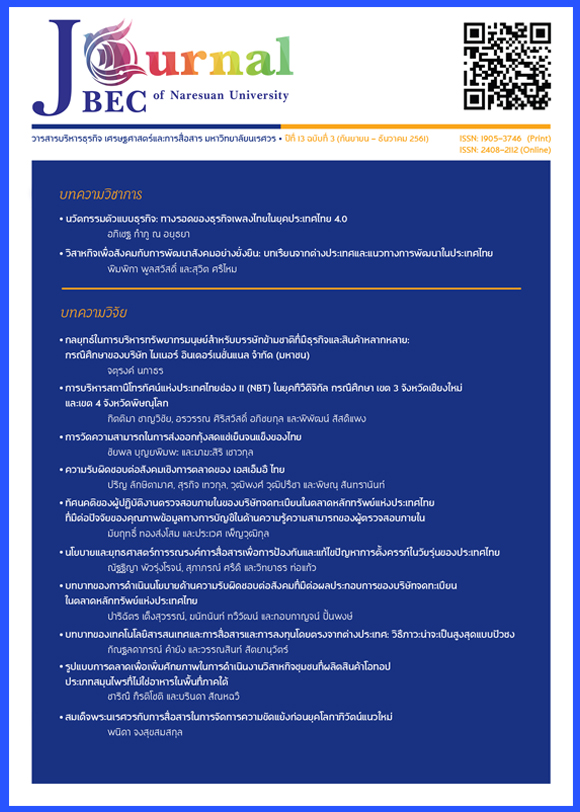บทบาทของเทคโนโลยีสารสนเทศและการสื่อสาร และการลงทุนโดยตรงจากต่างประเทศ: วิธีภาวะน่าจะเป็นสูงสุดแบบปัวซง
Main Article Content
บทคัดย่อ
บทความนี้ศึกษาผลกระทบของปัจจัยไอซีทีต่อการไหลเข้าของเงินลงทุนโดยตรงจากต่างประเทศ กลุ่มตัวอย่างครอบคลุม 43 ประเทศ ครอบคลุมทั้งประเทศพัฒนาแล้วและประเทศกำลังพัฒนา ระหว่างปี 2007-2013 ข้อมูลที่ใช้มาจากรายงานข้อมูลเทคโนโลยีของโลกอันประกอบด้วย 18 องค์ประกอบย่อย การวิเคราะห์ถดถอยด้วยวิธีภาวะน่าจะเป็นสูงสุดแบบปัวซง (Poisson Pseudo-Maximum Likelihood Estimation) และกลั่นกรองด้วยการทดสอบแรมซี่ (Ramsey Reset Test) ควบคู่กับการใช้ค่าคลาดเคลื่อนมาตรฐานที่มีความแกร่ง (Robust Standard Error) ชี้ให้เห็นว่าปรากฏนัยสำคัญทางสถิติระหว่างปัจจัยไอซีทีและการไหลเข้าของเงินลงทุนโดยตรงจากต่างประเทศ จากจำนวน 18 ปัจจัยย่อย พบว่า 4 ปัจจัยย่อยแสดงผลกระทบทางบวกต่อการไหลเข้าของเงินลงทุนโดยตรงจากต่างประเทศ ผลดังกล่าวยืนยันความสำคัญของปัจจัยไอซีทีต่อการส่งการลงทุน
Article Details
References
Addison, T., & Heshmati, A. (2004). The New Global Determinants of FDI Flows to Developing Countries: The Importance of ICT and Democratization. In Monetary Integration, Markets and Regulations: Research in Banking and Finance Volume 4 (pp. 151-86). Amsterdam: Elsvier.
Addison, T., & Heshmati, A. (2003). The new global determinants of FDI flws to developing countries. World Institute for Development Economics Research.
Behera, S. R., & Dua, P. (2012). Foreign Direct Investment and Technology Spillover: Evidence Across Indian Manufacturing Industries. Sigapore Economic Review , 57 (2).
Blonigen, B. A. (2005). A Review of the Empirical Literature on FDI Determinants. Atlantic Economics Journal.
Borensztein, E., Gregorio, J. D., & Lee, J.-W. (1998). How does foreign direct investment affect economic growth? Journal of International Economics , 45, 115-135.
Caves, R. E. (1971). International Corporations: The Industrial Economics of Foreign Investment. Economics , 38 (149), 1-27.
CID. (2003, April). Global Trade Negotiation. Retrieved July 11, 2017, from Center for International Development at Harvard University: http://www.cid.harvard.edu/cidtrade/issues/washington.html
Duttaray, M., Dutt, A. K., & Mukhopadhyay, K. (2008). Foreign direct investment and economic growth in less developed countries: an empirical study of causality and mechanisms. Applied Economics , 40 (15).
Gani, A., & Sharma, B. (2003). The efffects of information technology achievement and diffusion on foreign direct investment. Perspectives on Global Development and Technology , 2 (2), 161-178.
Gholami, R., Lee, S.-Y. T., & Heshmati, A. (2006). The causal relationship between information and communication technology and foreign direct investment. The World Economy , 29 (1), 43-62.
John , K., & Farid, T. (2010). Gravity For FDI. International Economics.
Kanta, M., & Klein, L. R. (1998). Economic growth and productivity gains from capital inflow: Some evidence for India. Journal of Quantitative Economics , 14, 81-108.
Li, H., Liu, Z., & Rebelo, I. (1998). Testing the Neoclassical Theory of Economic Growth: Evidence from Chinese Provinces. Economics of Planning , 31, 117-132.
MacPhee, C. R., & Sattayanuwat, W. (2014). Consequence of Regional Trade Agreements to Developing Countries. Journal of Economic Integration , 29 (1), 64-94.
Makki, S. S., & Somwaru, A. (2004). Impact of Foreign Direct Investment and Trade on Economic Growth: Evidence From Developing Countries. American Journal of Agricultural Economics (August), 795-801.
Matambalya, F., & Wolf, S. (2001). The role of ICT for the performance of SMEs in East Africa: empirical evidence from Kenya and Tanzania. ZEF Discussion Papers on Development Policy , 42.
Moosa, I. A. (2002). Foreign Direct Investment: Theory, Evidence and Practice. PALGRAVE.
OECD. (2017, 2 3). Comapre your country. Retrieved 9 17, 2017, from http://www2.compareyourcountry.org/service-trade-restrictions#
Ramirez, M. D. (2000). Foreign Direct Investment in Mexico: A Cointergration Analysis. The Journal of Development Studies , 37 (1), 138-162.
Silva, J. S., & Tenreyro, S. (2006). The Log of Gravity. Review of Economics and Statistics , 88 (4), 641-658.
Soper, D. S., Demirkan, H., Goul, M., & Louis, R. S. (2012). An Empirical Examination of the Impact of ICT Investment on Future Levels of Institutionalized Democracy and FDI in Emerging Societies. Journal of the Association for Information Systems , 13 (3), 116-149.
Zhang, K. H. (2001). How does foreign direct investment affect growth in China? Economics of Transition , 3, 679-693.
จินตนา ประสาร. (2555). ความสัมพันธ์ระหว่างการลงทุนโดยตรงจากต่างประเทศกับอัตราแลกเปลี่ยนของไทย. กรุงเทพ: มหาวิทยาลัยรามคำแหง.
ณัฏฐากัญญ์ สุคำ. (2548). ปัจจัยที่กำหนดการลงทุนโดยตรงจากต่างประเทศในธุรกิจค้าปลีกในประเทศไทย. กรุงเทพ: มหาวิทยาลัยเกษตรศาสตร์.
ธนญา นันทิวรรธน์. (2555). การลงทุนโดยตรงจากต่างประเทศของประเทศสาธารณะรัฐประชาชนลาว. กรุงเทพ: มหาวิทยาลัยรามคำแหง.
นันท์นภัส เลิศจรรยารักษ์. (2548). การวิเคราะห์ความสัมพันธ์ระหว่างตัวแปรเศรษฐกิจมหภาคและการลงทุนโดยตรงจากต่างประเทศในประเทศไทย. เชียงใหม่: มหาวิทยาลัยเชียงใหม่.
ภูวดล ทิมะณี. (2552). การทดสอบความสัมพันธ์ระหว่างอัตาดอกเบี้ยกับการลงทุนโดยตรงจากต่างประเทศโดยวิธีไบวาร์ริเอทดาร์ช. เชียงใหม่: มหาวิทยาลัยเชียงใหม่.
วราภรณ์ โภคภิรมย์. (2547). ความสัมพันธ์ของการค้าระหว่างประเทศและการลงทุนโดยตรงจากต่างประเทศที่มีต่อการเจริญเติบโตทางเศรษฐกิจ. กรุงเทพ: มหาวิทยาลัยรามคำแหง.
อภิญญา ละอองเอก. (2554). ปัจจัยทางเศรษฐกิจมหภาคที่มีผลต่อการลงทุนโดยตรงจากต่างประเทศในภูมิภาคอาเซียน. กรุงเทพ: มหาวิทยาลัยเกษตรศาสตร์.

